For those unfamiliar, the speed you go in Zwift is entirely based on your weight and power output - with some added trimmings, including height/virtual bike/wheels/etc... But really, it all hinges on your weight. As a good citizen of Zwift racing or group rides, your weight should be accurate. For higher-end competitions on Zwift, racers have to film themselves stepping on bathroom scales multiple times in a single long-form video shot, as if it were a Dancing With the Stars competition. #Seriously
However, most notable is that earlier this week, Zwift implemented a fix for Fitbit WiFi & Smart Scales, which allows those scales to update your Zwift weight again. But it also acts as a workaround for Withings WiFi Scales to update, since that's still broken. This ensures that after you finish sweating it out in the sauna and going to the bathroom, that you can simply step on the scale and update Zwift automatically. However, in the midst of all that, a DCR Reader cleverly made the observation that his super cheap no-name smart scale could take advantage of that same path to sync to Zwift.
Thus, off to Amazon I went to order a $17 scale from a brand I've never heard of. While there are numerous 1byone scales (but only one horribly bad name), I selected the cheapest one. They also have a slightly different looking variant that says it gives you BMI as well, that costs another $7, but is at least offered in black. Though, as you'll see - the cheaper one gave me BMI anyway. And less you think this is some random piece of junk - it's at least managed 3,752 ratings averaging 4.5/5 stars on Amazon. So...I suppose that's good.
This post will not be a crazy in-depth review of the inner workings of this scale. Namely because frankly, I already hate writing scale reviews as it is. And secondly, I'm here for one thing only:
1) Is this scale weight-accurate?
2) And does it sync to Zwift properly?
Ok, I guess that's two things. Anyway, let's get moving onto the scale.
The Scale Details:
The scale has essentially the same packaging as any other scale - a few pieces of thin foam, a plastic baggie, and nicely, three AAA batteries. Oh, and some paper manual stuffs.
You'll stick the three batteries in the underside:
And then you'll scan the QR code on the paper manual to download and install the app:
The app is pretty straightforward. First, you'll enter your biographical information, which is used for computing BMI and such. Also, the app is what sends the data over to Fitbit and in turn Zwift. Remember this is a Bluetooth Scale, not a WiFi scale. As such, your phone will have to be around-ish for it to connect to the phone and sync it over. The pairing process only takes a second or two:
Now we'll connect up the scale to Fitbit and then Zwift in the next section. So if you don't care about unnecessary details of a weight scale, just skip to that section. But since this post does have the word 'Review' in it (albeit minus the in-depth part), I'll at least show you the basics.
To weigh-in you'll simply step on the scale, which will then show your weight listed on the face of the scale, as well as a Bluetooth icon that I managed not to catch here in this photo that indicates whether or not its syncing the data:
You can change the scale measurement type between: kilograms, pounds, stones, and stones:pounds (showing both).
Once you've weighed in, it'll sync to your phone. The app indicates you can also create secondary users in your app on your phone, or, another person can setup the app on their phone and pair it to the scale as well. You can see all the metrics listed below from this scale:
Somewhat interestingly, the version I bought said it didn't include these additional impedance-based metrics...but...turns out it does. Impedance-based metrics are the ones that are derived from an electrical signal being sent via the small pads you see on the scale through your body to try and determine aspects like body fat or water weight. I've shown in many posts over the years, including bringing in half a dozen people to compare against a BodPod, that these metrics tend to be all over the map.
However, strict weight tends to be very similar across virtually every scale I test - and that includes this cheap $17 scale. In comparing it to a Garmin Index S1, Garmin Index S2, and Fitbit scale, all scales registered within 0.3lbs. The scale has a gradation of 0.2lbs/0.1kg, with a max weight of 400lbs (180kg). Again, I wouldn't really trust the other non-weight metrics, but then again, I don't really find much value in them either for what I use the scale for.
The app also includes the ability to sync with Apple Health automatically if on iOS (and Google Fit on android), as well as Fitbit (which we'll take advantage of in a second). Further, there's a cloud storage capability, a well as the ability to simply export all our weight measurements (including things like BMI/water weight/etc...) as a CSV file - which is kinda nice.
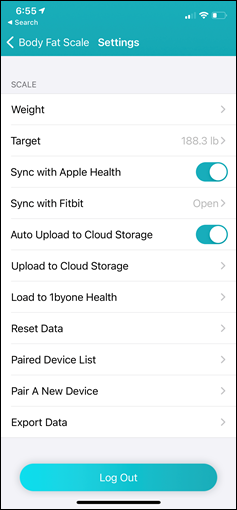
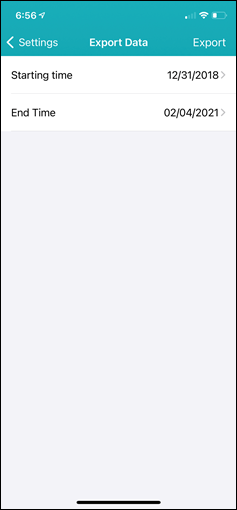

There's also the ability to plot/chart the data over time, and look at the calendar view of your data. In addition you can set a goal and weigh-in reminder too. All things that for what I want to use this scale for (syncing to Zwift), I don't really care too much about.
And thus completes this quick-review tour of the 1byone scale. Now, let's get it hooked up to sync weight into Zwift.
Connecting to Zwift:
The 1byone smart scale doesn't connect directly to Zwift. Instead, it takes advantage of Fitbit's impressively large partnership and API integrations, allowing it to update your weight data on the Fitbit platform. But you need not actually need a Fitbit device to create a Fitbit account (since you can actually use their app without a Fitbit device, as a way for them to tempt you into buying an activity tracker).
So we'll first set up a Fitbit account, then set up sync between Zwift and Fitbit, and then set up sync between 1byone and Fitbit. This sounds long, but in reality it'll take us about 2-3 minutes.
Again, you do NOT need a Fitbit device for this to work. While I do have many Fitbit devices, I'm actually going to demonstrate it with a brand-spanking-new clean Fitbit account that's never been tied to any Fitbit device. To do that, head over to Fitbit's sign-up page:
Then enter in your bio information, or, really, whatever you want here. It won't be sent to Zwift.
Then, fill out your height/age/weight information. Again, the purpose of this is that it's normally used for other Fitbit things. Notably, in case you were wondering, Google agreed to not use fitness related data from the Fitbit acquisition. Whether they do or don't, I've got no idea.
Once that's done, remember to go and verify the account via the e-mail you got from Fitbit:
Good, your Fitbit bits are done now! Off to Zwift we go.
Login to Zwift.com, and then in the upper right corner click your profile icon and select 'My Profile'
Next, on the next page click 'Connections'.
Following that, scroll down and click on the 'Connect' button below Fitbit.
That'll bring you to a standard issue authentication/authorization page. While in theory you can just select the weight only, I just selected them all. Then click 'Allow'.
It'll zip you back to Zwift, where it'll show that it's successful.
Last but not least, we'll connect up our 1byone scale to Fitbit to complete this awkward threesome. To do that, hit the settings icon in the upper left corner, and then choose 'Sync with Fitbit':
You'll then get yourself the standard Fitbit authorization page, followed by the standard Fitbit permissions page. Again, like above, I suspect you could just choose the weight-only option here. Maybe I'll try it another day (Update: No, you can't, if you try that, it fails.).
At this point you're done!
Simply step on the scale and watch magic happen.In my testing, the update across all three platforms is less than a minute. It seems to happen near-instantly (couple of seconds) between 1byone and Fitbit, and then appears to take slightly longer for the update to show up on Zwift, seemingly about 30-60 seconds.
Additionally, if you're playing McRefreshy, I noticed the Zwift Companion app Seems to need closing the entire app and re-opening to grab the new value, whereas the website shows it upon a single refresh. My guess is that the Zwift Companion App probably has a cache duration before it updates the value, whereby re-opening the app overrides that. But practically speaking, this all happens instantly.
Here you can see a simple sequence, of before weigh-in on Zwift where I had forced it to a higher value earlier, the weigh-in on the scale, and then the after on Zwift again.
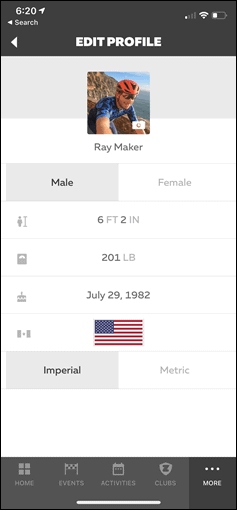
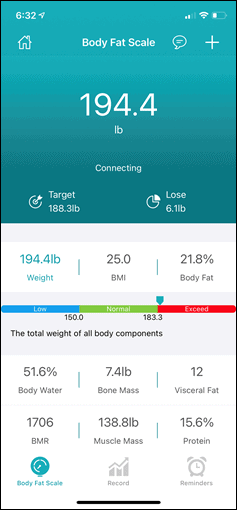
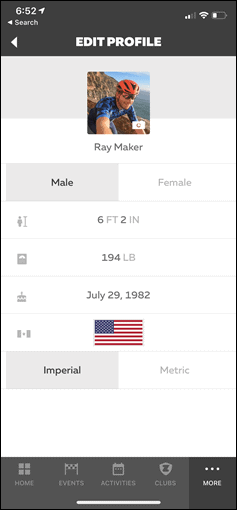
Now one downside here is that it does not appear to background sync (at least on iOS). Meaning, you have to open the app for it to sync. However, it does save past weigh-ins when the phone wasn't around. That doesn't matter for Zwift per se, but it does handily sync them to the rest of the platform. So that is a distinct advantage for WiFi scales.
And finally, while unrelated - I know some of you will ask: What about Garmin Index scale users and their $150 scales? While it would be trivial for Zwift to accept the weight data that comes across via .FIT file updates from Garmin automatic syncs, Zwift hasn't done this. Just as they haven't fixed it yet for Withings/Nokia scales. Why? I don't know. But, in the meantime, you can use FitnessSyncer.
I totally understand that most Zwifters don't really care that their weight is updated correctly on Zwift. And, given that Zwift's apps never remind you to update your weight, I'm not terribly convinced they care either. But, for folks that want a method that doesn't require thinking about it very much - this seems like a good option. Or perhaps more importantly, a cheap option. And as I've said before - if there's one thing I've learned folks like, it's simple and cheap gadgets and options.
I'm not terribly sure what else to say about a product like this - it just works. Sure, it doesn't have WiFi - which would be great to minimize ensuring the phone app is still alive somewhere in the background, but that's a minor thing in this particular case. So, go forth and pick up the bathroom hardware you never knew you wanted.
With that - thanks for reading!
Found This Post Useful? Support The Site!
Hopefully you found this review useful. At the end of the day, I'm an athlete just like you looking for the most detail possible on a new purchase - so my review is written from the standpoint of how I used the device. The reviews generally take a lot of hours to put together, so it's a fair bit of work (and labor of love). As you probably noticed by looking below, I also take time to answer all the questions posted in the comments - and there's quite a bit of detail in there as well.
If you're shopping for the 1byone Smart Weight Scale or any other accessory items, please consider using the affiliate links below! As an Amazon Associate I earn from qualifying purchases. It doesn't cost you anything extra, but your purchases help support this website a lot. Even more, if you use Backcountry.com or Competitive Cyclist with coupon code DCRAINMAKER, first time users save 15% on applicable products!
And finally, here's a handy list of trainer accessories that most folks getting a smart trainer for the first time might not have already:
And of course - you can always sign-up to be a DCR Supporter! That gets you an ad-free DCR, access to the DCR Quarantine Corner video series packed with behind the scenes tidbits...and it also makes you awesome. And being awesome is what it's all about!
Thanks for reading! And as always, feel free to post comments or questions in the comments section below, I'll be happy to try and answer them as quickly as possible. And lastly, if you felt this review was useful - I always appreciate feedback in the comments below. Thanks!

